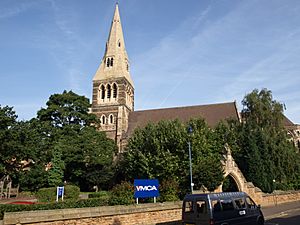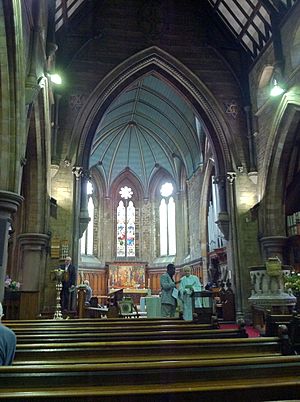All Saints' Church, Nottingham facts for kids
Quick facts for kids All Saints' Church Nottingham |
|
|---|---|
 |
|
| Denomination | Church of England |
| Churchmanship | Broad Church |
| Website | http://www.nottinghamchurches.org |
| History | |
| Dedication | All Saints' |
| Architecture | |
| Architect(s) | Thomas Chambers Hine |
| Style | Gothic Revival |
| Groundbreaking | 1863 |
| Completed | 1864 |
| Construction cost | £25,000 |
| Specifications | |
| Capacity | 300 |
| Spire height | 175 feet (53 m) |
| Administration | |
| Parish | St Peter and All Saints |
| Diocese | Southwell and Nottingham |
| Province | Province of York |
All Saints' Church, Nottingham is a beautiful old church in Nottingham, England. It belongs to the Church of England, which is a Christian church.
This church is very special! It's listed as a Grade II listed building. This means the government thinks it's really important for its history or amazing design.
Contents
About All Saints' Church
All Saints' Church used to be its own parish church. A parish is like a local area that a church serves. Over time, it joined with other churches in Nottingham. Now, it's one of three churches in the parish of All Saints', St. Mary's and St. Peter's, Nottingham.
The building itself is a great example of Victorian architecture. This means it was built during the time of Queen Victoria, which was from 1837 to 1901.
Church History
The church was built a long time ago, between 1863 and 1864. It's mostly made of sandstone. A kind person named William Windley JP paid for most of it. He was a local person who liked to help his community. He paid for the church, a large house for the vicar (the church leader), and a church school. The total cost was about £25,000 back then!
The church was designed in a style called Gothic revival. This style brings back ideas from old Gothic churches, like pointed arches and tall spires. It was built to hold 500 people. It has a tall, pointy tower called a broach spire, which is about 175 feet (53 meters) high. This makes it one of the tallest buildings in Nottingham! The spire also holds ten bells.
The church was officially opened on 3 November 1864. Many people came to the opening, including the Bishop of Lincoln. The choir from St. Mary's Church, Nottingham sang, and there was music played on a harmonium.
When it was first built, All Saints' was in a new, rich part of Nottingham. This area was growing because of a serious illness called cholera in the 1830s. Over the years, Nottingham grew bigger, and the area around the church became an inner-city neighborhood. After the Second World War, the area changed a lot.
The old school building, which wasn't used for school anymore, was turned into small workspaces. Part of the large vicarage (the vicar's house) was made into homes for young people. In 2006, the old school building was bought to be used by local groups.
Today, the church and many other buildings around it are still Grade II listed. The church is still used for services every Sunday.
Past Vicars
Here are some of the people who led the church over the years:
- Edwin Gyles (1864-1880)
- Alfred Pearson (1880-1888)
- Hubert Arnold Gem (1888-1902)
- Thomas Wilson Windley (1902-1912)
- Herbert Lovell Clarke (1912-1923)
- W.H.M. Lonsdale (1923-1929)
- C.H. Weller (1929-1937)
- Edward Frederick H Dunnicliffe (1937-1946)
- T.W. Richardson (1946-1950)
- Charles W. Harrington (1950-1955)
- John N.D. Perkins (1955-1979)
- Paul George Watts (1980-1984)
- Nigel Peyton (1985-1991)
- David White (1992-1998)
- Gilly Myers (priest-in-charge) (2000-2002)
Church Bells
The church has ten bells! The first six bells were made by John Taylor & Co in 1864. Later, two more bells were added. In 1999, the bells were tuned and put into a new steel frame. At the same time, an old bell from the All Saints’ School was added as a special bell called a Sanctus bell.
The Nottingham University Society of Change Ringers often practice ringing the bells here. They also ring them for church services.
In May 2019, the bells stopped ringing because of safety problems. Pigeons had gotten into the bell tower and made nests. Their waste had damaged the floor above the bells, making it rotten.
A group from the Nottingham University Society of Change Ringers helped fix the tower. They cleaned out about 2.2 tons of bird waste! They also built a new floor above the bells. This new floor helps support the spire and makes it safer for future work. They also fixed up the ringing chamber, which is where the bell ringers stand.
The bells were heard again on 8 February 2020 during a test ring. They were officially ready for ringing again on 11 February 2020!
Church Organ
The first organ in the church was built in 1865 by Lloyd and Dudgeon from Nottingham.
The organ used today was made by Norman and Beard in 1906.
Organists
Here are some of the people who played the organ at All Saints' Church:
- George Essex (1865 - 1883)
- G. H. Woodhouse (1883 - 1899)
- Arthur Richards (1899 - 1915)
- Frederick William Hughes (1915 - 1918)
- Frederick George Ainsworth Wyatt (1918 - 1947)
- Eric Rayner (1947 - 1972)
- Peter C Price (1973 - 1977)
- Malcolm Batchelor
- Jean Bruce
- Peter Moule
Today, there isn't one regular organist. A team of organists plays for both St Peter's and All Saints' churches. Peter Siepmann is in charge of the music.
See also
- Listed buildings in Nottingham (Hyson Green and Arboretum ward)
- Nottingham University Society of Change Ringers
- St. Mary's Church, Nottingham
- St. Peter's Church, Nottingham


